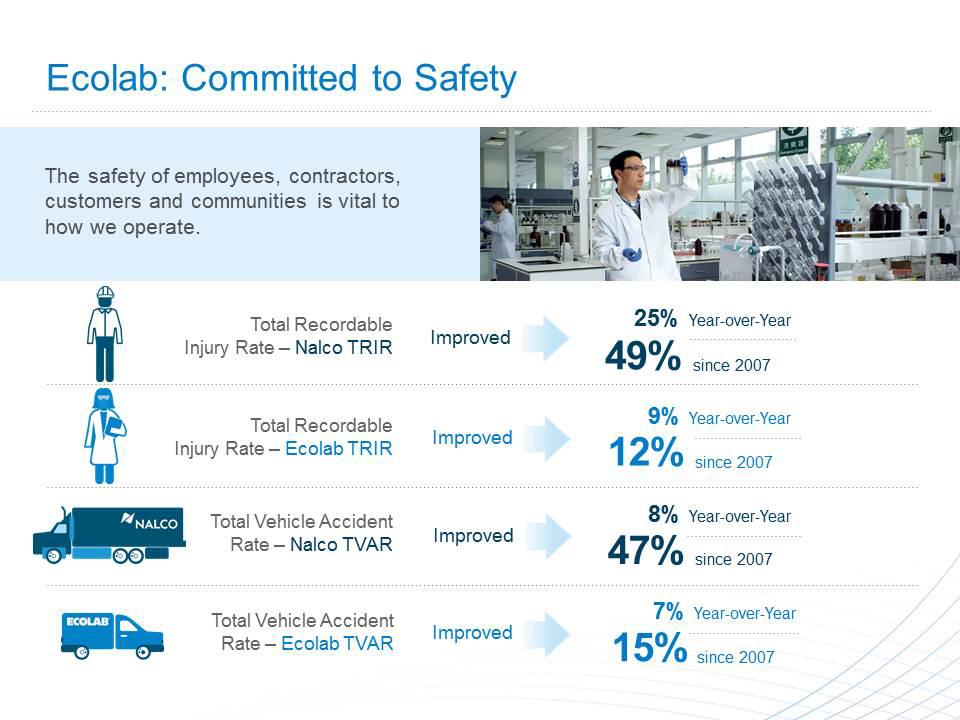Ecolab’s Safety Commitment
Working to ensure the safety of our employees, contractors, customers and communities

Safety is a critical part of how we work and is gaining renewed focus as we combine Ecolab and Nalco systems, processes and programs to shape our new safety culture. This effort provides the opportunity to take the best from each to ensure constant progress toward our goals of zero — zero accidents, injuries, fatalities and releases.
Globally we are deploying these best practices across three dimensions: Cultural, Structural and Quantitative. Culturally, we want to make safety a personal value for all employees.
Our “Reaching Hearts and Minds” communications campaign encourages employees to be accountable for their own safety and for the safety of those around them, 24 hours a day, seven days a week, 365 days a year.
We are driving structural best practices to manage risk and improve results. For example, we’re expanding Ecolab’s Compliance Assessment Process (ECAP) to improve safety, health and environmental compliance and reduce risk within manufacturing, sales, R&D and logistics. One of the greatest risks we face daily is driving. Our use of onboard monitoring devices provides drivers with immediate feedback that improves their behavior and encourages safe driving habits. Other best practices include fostering employee well-being through industrial hygiene, surveillance monitoring and ergonomic programs.
Leaders are accountable for the actions of those they supervise and we seek to create an atmosphere that not only makes it acceptable to identify and point out unsafe practices, but essential. We have instituted a Safety Leadership training course to integrate safety into leadership at all levels of the organization.
We track recordable injuries and vehicle accidents even though they are lagging indicators because it is important to quantify our performance. We are even more focused on leading indicators — activities that drive or help us predict future performance. These are critical in helping us cultivate a proactive, preventive mindset. Leading indicators focus on behaviors and activities we are trying to encourage including:
- Performing risk assessments (identifying potential workplace hazards)
- Participating in safety training
- Reporting near-miss incidents, and
- Responding to the recommended improvements from our ECAP audits.
Our Performance
在我们的工作场所安全性的关键绩效指标中,有公认的行业措施:可记录的总伤害率(TRIR)和总车祸率(TVAR)。TRIR是每100名全职工人的伤害率。TVAR是每百万英里驱动的事故数量。对于Nalco在2011年,TRIR比2010年下降了25%。在0.43处,这是Nalco历史上最低的TRIR,超过了我们的目标0.48。这使Nalco跻身于我们行业中最高的25%。自2007年以来,TRIR已减少了49%以上。
The TVAR for Nalco dropped 8 percent from 2010 to 2.1, exceeding the goal of 3.0. The TVAR has improved for three consecutive years and declined by 47 percent since 2007. Nalco also tracked the Severe Vehicle Accident Rate (SVAR) which measures driving accidents resulting in death, bodily injury, disabling or rollover of a vehicle. In 2011, the rate improved 8 percent to 0.22, exceeding our goal of 0.27. It has improved 63 percent since we began tracking the measurement in 2008.
Ecolab Trir也提高了9%,2011年从2010年的4.67降至4.25。这幅度减少了47次。自2007年以来,TRIR的速度已减少了11.6%。2011年,Ecolab的TVAR为6.2,比2010年提高了6.7%,自2007年以来提高了15.3%。
有关我们性能的其他信息,请访问此报告的详细附录www.ecolab.com/csr.
